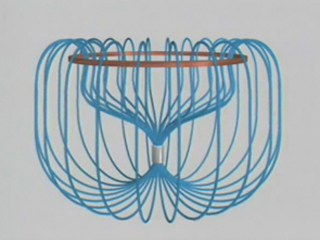| DESCRIPTION:
A magnet
is suspended below a superconducting ring. As the magnet falls
under gravity, a current is induced in the ring that
tries to keep the magnetic flux through the area of
the ring constant. This corresponds to a field that
produces a force that opposes the motion of the magnet. As the magnet falls below the ring, the induced current generates
a field that pulls the magnet upwards from above.
In this
case, since the ring has zero resistance, the flux through
it remains constant. In addition, the magnet is light
enough that the force from the induced field balances
that of gravity, causing the magnet to hang, suspended below
the ring. If the magnet were heavier, it would fall far below the ring, leaving an pernanent eddy current in the superconducting ring that produces exactly the flux through the ring that the magnet produced before it began to fall.
The first animation shows the magnetic field configuration
around a magnet as it falls and rebounds. The current
in the ring is indicated by the small moving spheres.
The motions of the field lines are in the direction
of the local Poynting flux vector.
The second animation shows a three-dimensional fieldline
representation of the same process.
Click on the images to see the animations.
|



